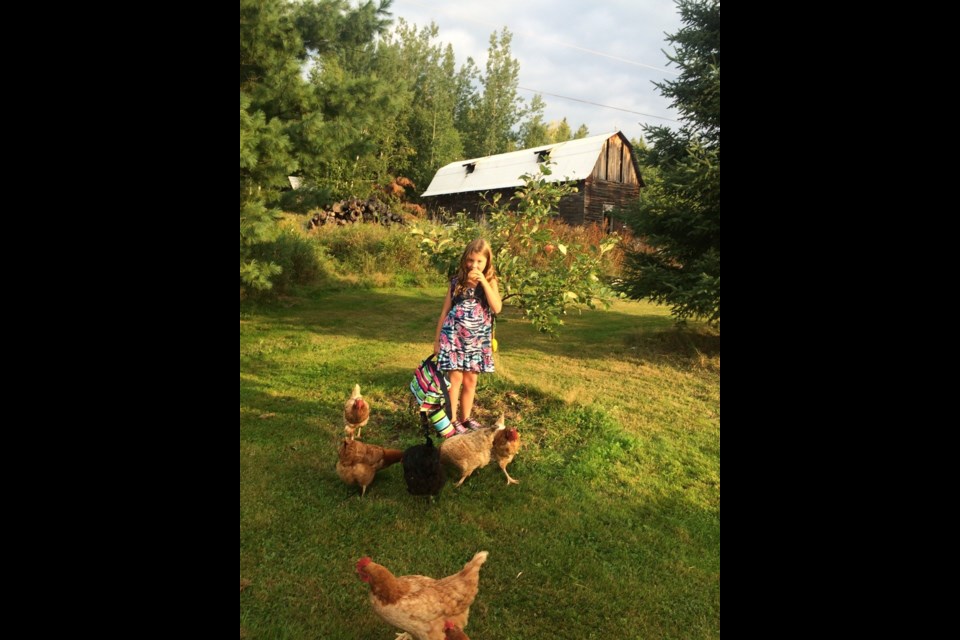James and Josee Morin raise their four children and make their livelihood on their family farm, Kipling Ridge Farms, down the highway in Verner.
“The taste, nutrient density and peace of mind that comes from our farming practices is hard to define both for us and our customers,” said James Morin.
Being part of the community, providing local residents with nutritious food, and supporting other local businesses are all important to Morin. These social and community benefits are a component of the guiding principle of the farm: Regenerative Agriculture.
“Regenerative Agriculture describes a way of farming and grazing that, among other benefits, can help to reverse climate change by rebuilding soil organic matter and restoring degraded soil biodiversity. Our planet’s soils currently hold about four trillion tons of carbon, and can hold a lot more with the right practices,” Morin said.
Mitigating climate change by building healthy, carbon-rich soil that will sequester carbon is something everyone can do in their own private or community garden. According to ‘The Climate-Friendly Gardener: A Guide to Combating Global Warming from the Ground Up,’ there are five steps for a climate-friendly garden:
Don’t add chemical fertilizers or pesticides;
Keep soil covered with growing plants or mulch;
Plant trees and shrubs;
Compost your food and garden waste and add organic matter to the soil;
Consider replacing lawn with a garden or trees.
Protecting and planting trees (afforestation) and protecting and building healthy soils (carbon sequestration in crop lands) are two of the most effective land-based actions for removing carbon from the atmosphere, identified in the Intergovernmental Panel on Climate Change’s Special Report on Climate Change and Land.
Depending on how we protect or use land, it can be a source of greenhouse gases, or take carbon dioxide out of the air and mitigate climate change. Currently, agriculture, forestry and other human land-use accounts for about a quarter of all human caused greenhouse gases, contributing to the climate crisis. By changing how we choose to use land, we can instead make it part of the solution, sequestering carbon while also increasing food security, ecosystem health, and air and water quality.
Sudbury’s Food Forests are an example of how all these different benefits can come together. “Food Forests, also called Edible Forest Gardens, are planted with fruit trees, shrubs, and other edible plants in such a way as to mimic woodland ecosystems. No pesticides or herbicides are used and once established, the gardens are relatively low maintenance, requiring no watering after the first season. The food produced is available to anyone in the community who wishes to harvest it,” explains Carrie Regenstrief of Sudbury Shared Harvest.
So far, there are five Food Forests in Greater Sudbury, with plans to establish one in each ward. The aim is to increase food security by making fresh local food available and building gardening and food literacy skills, while also providing environmental benefits.
“Edible landscapes also increase the diversity of insect populations, create habitat for birds and other wildlife, and provide ideal conditions for the millions of microbes that make up healthy soil, which is critically important for their ability to store carbon and slow climate change.” Regenstrief explains.
It turns out that we have a lot to gain by seeing our farms, our yards, and our public spaces in their full potential as carbon sinks, sources of food, ecosystems, and more. A lot can happen with just a shift of perspective. Supportive policies and resources are the extra boost needed to make change happen faster.
Naomi Grant co-chairs Coalition for a Liveable Sudbury. Coalition for a Liveable Sudbury is a grassroots group of citizens and community groups who share a vision of Sudbury as a green, healthy and engaged community. For additional information on a net zero future for Greater Sudbury, see the group's website.
